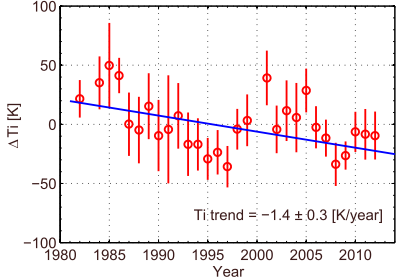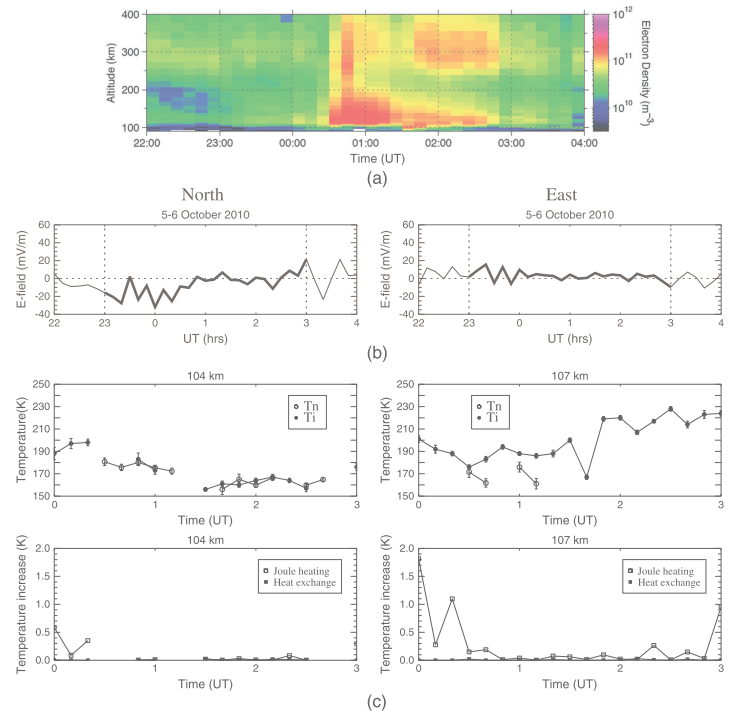Upper atmosphere cooling over the past 33 years (Ogawa et al., GRL, 2014)2017.2.18
Figure: The residual ion temperature at 310-340 km altitude after removal of the solar effects (in red) and a linear fit to it (in blue).
Theoretical models and observations have suggested that the increasing greenhouse gas concentration in the troposphere causes the upper atmosphere to cool and contract. However, our understanding of the long-term trends in the upper atmosphere is still quite incomplete, due to a limited amount of available and well-calibrated data. The European Incoherent Scatter (EISCAT) radar has gathered data in the polar ionosphere above Tromsø for over 33 years. Using this long-term data set, we have estimated the first significant trends of ion temperature at altitudes between 200 and 450 km. The estimated trends indicate a cooling of 10-15 K/decade near the F region peak (220-380 km altitude), whereas above 400 km the trend is nearly zero or even warming. The height profiles of the observed trends are close to those predicted by recent atmospheric general circulation models. Our results are the first quantitative confirmation of the simulations and of the qualitative expectations.
Ogawa, Y., T. Motoba, S. C. Buchert, I. Häggström, and S. Nozawa (2014), Upper atmosphere cooling over the past 33 years, Geophys. Res. Lett., 41, 5629–5635, doi:10.1002/2014GL060591.
カテゴリ:Atmosphere,Long Term
Variations of the neutral temperature and sodium density between 80 and 107 km above Tromsoe during the winter of 2010-2011 by a new solid state sodium LIDAR (Nozawa et al., JGR, 2014)2017.2.18
Figure: (a) Temporal and altitude variations of the electron density observed with the EISCAT UHF radar at Tromsø are shown from 2200 UT on 5 October to 0400 UT on 6 October 2010. (b) Temporal variations of the electric field of the (left) northward and (right) eastward components observed with the EISCAT UHF radar at Tromsø are shown from 2200 UT on 5 October to 0400 UT on 6 October 2010. Thicker lines denote the electric field values during the simultaneous observations with the sodium lidar. (c) Comparison of neutral (open circle: lidar) and ion (solid circle: EISCAT) temperatures (top left) at 104 km and (top right) at 107 km are shown from 0000 UT to 0300 UT on 6 October 2010. Vertical line associated with each symbol denotes its error value. Calculated temperature increase due to Joule heat (open square) and electron-ion heat exchange (solid square) derived by EISCAT data (bottom left) at 104 km and (bottom right) at 107 km are shown.
A new solid-state sodium lidar installed at Ramfjordmoen, Tromsø (69.6 N, 19.2 E), started observations of neutral temperature together with sodium density in the mesosphere-lower thermosphere (MLT) region on 1 October 2010. The new lidar provided temperature data with a time resolution of 10 min and with good quality between 80 and 105 km from October 2010 to March 2011. This paper aims at introducing the new lidar with its observational results obtained over the first 6 months of observations. We succeeded in obtaining neutral temperature and sodium density data of ~255.5 h in total. In order to evaluate our observations, we compared (1) the sodium density with that published in the literature, (2) average temperature and column sodium density data with those obtained with Arctic Lidar Observatory for Middle Atmosphere Research Weber sodium lidar, and (3) the neutral temperature data with those obtained by Sounding of the Atmosphere with Broadband Emission Radiometry/Thermosphere Ionosphere Mesosphere Energetics and Dynamics satellite. For the night of 5 October 2010, we succeeded in conducting simultaneous observations of the new lidar and the European Incoherent Scatter UHF radar with the tristatic Common Program 1 (CP-1) mode. Comparisons of neutral and ion temperatures showed a good agreement at 104 km between 0050 and 0230 UT on 6 October 2010 when the electric field strength was smaller, while significant deviations (up to 25 K) are found at 107 km. We evaluated contributions of Joule heating and electron-ion heat exchange, but derived values seem to be underestimated.
Nozawa, S., T. D. Kawahara, N. Saito, C. M. Hall, T. T. Tsuda, T. Kawabata, S. Wada, A. Brekke, T. Takahashi, H. Fujiwara, Y. Ogawa, and R. Fujii (2014), Variations of the neutral temperature and sodium density between 80 and 107 km above Tromsø during the winter of 2010–2011 by a new solid-state sodium lidar, J. Geophys. Res. Space Physics, 119, 441–451, doi:10.1002/2013JA019520.
カテゴリ:Atmosphere,Ionosphere


